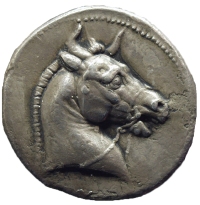skip to main |
skip to sidebar
SCADS: Seleucid Coins Addenda System
SCADS: Seleucid Coins Addenda System

In 2002 and 2008 the American Numismatic Society and Classical Numismatic Group published the two parts of Seleucid Coins: A Comprehensive Catalogue, by Arthur Houghton, Catharine Lorber, and Oliver Hoover.
The first part, by Houghton and Lorber, presented and interpreted all
the numismatic material for Seleucus I to Antiochus III known up to
2002. The second part, by Houghton, Lorber, and Hoover, did the same for
the Seleucid kings from Seleucus IV to Antiochus XIII. In total, more
than 2,491 primary coin types were published in these volumes.
No sooner had these important books come out in print than new types
and varieties began to appear at the rate of almost 100 a year. This
rapid growth of material made necessary the development of a system that
could keep up with the coins. The Seleucid Coins Addenda
System (SCADS) is intended to provide online access to the new material
that has appeared since 2008. As there is no indication that the flow of
previously unrecorded types and varieties will stop anytime soon, it is
expected that the SCADS database will continue to grow over time.
Interested parties will be instantly notified of new additions to the
database through alerts on Facebook, Twitter, and direct email
subscription.
The coins in the SCADS database are categorized by ruler, making it
easy for users to find all new entries for a particular king with a
single click. Extensive tagging of entry content allows for full
searchability. Thus, for example, a user interested in all new material
depicting Apollo would simply enter “Apollo” as the search criterion
and SCADS would provide all the relevant entries. If a user was
interested only in Apollo on issues of bronze denomination C,
“denomination C” could be added to narrow down the search. The coins in
the database have all been given a unique catalogue number (SCADS1,
SCADS2, SCADS3, etc.) for ease of reference, but these only reflect the
order of entry and are not tied to the numbering system used in the Seleucid Coins volumes.










 Stumble It!
Stumble It!

No comments:
Post a Comment